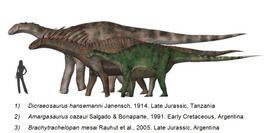Phylum Chordata Scientific name Dicraeosauridae Rank Family | ||
 | ||
Similar Dinosaur, Diplodocoidea, Rebbachisauridae, Amargasaurus, Dicraeosaurus | ||
Dicraeosauridae is a family of diplodocoid sauropods who are the sister group to Diplodocidae. Dicraesaurids are a part of the Flagellicaudata, along with Diplodocidae. Dicraeosauridae includes genera such as Amargasaurus, Suuwassea, Dicraeosaurus, and Brachytrachelopan. Specimens of this family have been found in North America, Africa, and South America. Their temporal range is from the Late Jurassic to the Middle Cretaceous. The only known Cretaceous survivor of the dicraeosaurids is Amargasaurus.
Contents
The group was first described by German paleontologist Werner Janensch in 1914 with the discovery of Dicraeosaurus in Tanzania. Dicraeosauridae are distinct from other sauropods because of their relatively short neck size and small body size.
The clade is monophyletic and well-supported phylogenetically with thirteen unambiguous synapomorphies uniting it. They likely diverged from Diplodocidae in the Mid-Jurassic, as evidenced by the diversity of dicraeosaurids in both South America and East Africa when Gondwana was still united by land. However, there is some disagreement among paleontologists on the phylogenetic placement of Suuwassea, the only genera of the Dicraeosauridae to be found in North America. It has been characterized as a basal dicraeosaurid by some and a member of the Diplodocidae by others. The placement of Suuwassea within Dicraeosauridae or Diplodocidae has substantial biogeographic implications for the evolution of Dicraeosauridae.
Classification
Dicraeosaurids are a part of Diplodocoidea and are the sister group to Diploidocidae. In the past two decades, the known diversity of the group has doubled. However, the classification of Suuwassea as a dicraeosaurid is not universally agreed upon. Some phylogenetic analyses have found Suuwassea to be a basal diplodocoid instead of a dicraeosaurid. One 2015 analysis has even found Dyslocosaurus and Dystrophaeus as members of Dicraeosauridae. A more recent reappraisal of Amargatitanis has placed it into the Dicraeosauridae, as well.
Dicraeosaurids are differentiated from their sister group, diplodocids, and from most sauropods by their relatively small body size and short necks. Dicraeosaurids are advanced sauropods within the monophyletic clade Neosauropoda, which is generally characterized by gigantism. The relatively small body size of dicraeosaurids make them an important outlier relative to other taxa in Neosauropoda.
Phylogeny
There are several different available phylogenies of Dicraeosauridae and the intra-group cladistics is not resolved. Suuwassea is variably positioned as either a basal dicraeosaurid or a basal diplodocoid. The most recent published phylogeny by Tschopp et al. is as follows. According to Tschopp et al., 2015:
Tschopp, interestingly, includes Dyslocosaurus and Dystrophaeus as dicraeosaurids, two groups traditionally not considered to be part of Dicaraeosauridae. The specimens of Dystrophaeus viamelae are highly fragmentary, with only a few bones available for study including an ulna, partial scapula, partial dorsal vertebrae, a distal radius, and some metacarpals. Dyslocosaurus polyonychius also has extremely limited fossil evidence that only includes appendicular elements, and the position of it in Tschopp's phylogeny is therefore considered "prelimintary."
Several paleontologists, however, do not include even Suuwassea in Dicraeosauridae, like Sereno et al. (2007); and JD Harris (2006). Other paleontologists, however, do include Suuwassea as a basal dicraeosaurid. The inclusion of Suuwassea as a basal dicraeosaurid makes the dicraeosaurids no longer an exclusively Gondwanan radiation. This is supported by Whitlock (2010); and Salgado et al. (2006).
Feeding Behavior
As sauropods, dicraeosaurids are obligate herbivores. Due to their relatively small necks and skull shape, it has been deducted that dicraeosaurids and diplodocids primarily browsed close to the ground or at mid height. Among the dicraeosurids, only Dicraeosaurus has well-preserved dentition. This makes it difficult for paleontologists to make definitive statements about Dicraeosauridae feeding behavior compared to diplodocid feeding behavior. However, compared to its known relatives, Dicraeosaurus is unique in that it has an equal number of teeth in the upper and lower jaw, though teeth in the lower jaw are replaced more slowly.
Anatomy
Dicraeosaurids are characterized by their relatively small body size, short necks, and long neural spines. They are 10–13 meters in body length. They share thirteen unambiguous synapomorphies including dorsal vertebrae without pleurocoels, the presence of a ventrally directed prong on the squamosal, and a subtriangular-shaped dentary symphysis.
Distribution and Evolution
Dicraeosaurid specimens have been found in three continents - Africa, South America, and North America. The distribution of species is primarily Gondwonan, with the exception of the North American Suuwassea. The presence of Suuwassea in North America is unique among dicraeosaurids, therefore making the proper taxonomic classification of Suuwassea essential. The group likely first diverged from the diplodocids in the middle Jurassic in North America and subsequently dispersed into Gondwana, with the most diversity in East Africa and South America. Amargasaurus was the latest surviving dicraeosaurid genus, living into the Early Cretaceous period.
